Japan is home to the faithful Hachiko and the Internet sensation Kabosu. However, there is more to Japan than the Akita Inu and the Shiba Inu. The Land of the Rising Sun has six dog breeds considered as natural treasures: the Shiba Inu, Akita Inu, Shikoku, Kishu, Kai Ken, and Hokkaido. The story of these majestic canines traces back thousands of years ago. Likewise, four other canines were developed in Japan.
Without further ado, here are 10 majestic canines from the Land of the Rising Sun!
The 6 National Treasures of Japan
Shiba Inu
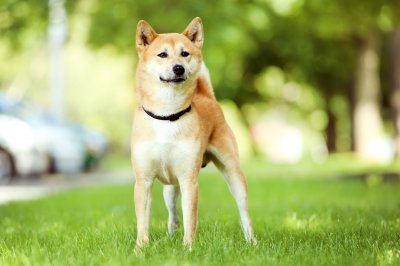
The Shiba Inu is often mistaken for other Japanese dogs, particularly the Akita Inu. However, the Shiba is the smallest canine among the original six native dogs of Japan, and he carries a distinct bloodline. While the breed may have only debuted in the AKC 27 years ago, he has already existed for more than 3,000 years. The National Geographic has confirmed that the Shiba Inu is a Basal breed. Simply put, he is an ancient dog breed that shares genetic ties with wolves more closely than most domesticated canines.
The Shiba Inu of the Jomon period used to hunt small and big game animals with his owner. Many believe that the breed’s name is coined from his tendency to run through brushwood during a hunt. Others assume it is because both the dog and the bushes are reddish-brown in color. The ravages of World War II, however, had pushed the Shiba Inu to the verge of extinction. Fortunately, breeding programs supported by the Japanese government have restocked the bloodlines.
Nowadays, this tenacious hunter has tickled our funny bones with his charm and quirks. A breed so popular, you can find Shibas in every nook and cranny of the Internet! As a matter of fact, the Shiba Inu is responsible for inspiring Doge memes that have been around since 2013. We also have YouTube sensation Mari the Shiba and men’s wear model Bodhi. Thanks to these trending canines, everyone got an inkling what it is like to have a Shiba Inu as a furry companion.
- Size: Medium
- Avg. weight: 18 – 24 lbs. (male), 15 – 20 lbs. (female)
- Shoulder height: 14.5 – 16.5 inches (male), 13.5 – 15.5 (female)
- Color variants: red sesame, cream, black sesame, black and tan
- Coat type: stiff and straight outer coat with a soft and thick undercoat
- Exercise requirements: 30 – 45 minutes at least 4x a week
- Personality: intelligent yet sometimes childlike, confident and strong-willed, loyal and affectionate, suspicious of strangers
Akita Inu
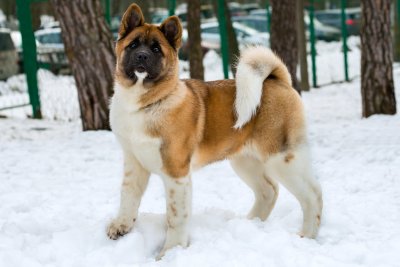
The Akita Inu is among the most highly regarded dog breeds in Japan. The story of Hachikō is one of the many reasons that fueled the ever-increasing popularity of the Akita Inu. If you visit Japan today, you will find a museum dedicated to Akitas in Odate City. There is also a bronze statue and a mosaic artwork of an Akita in the Shibuya Train Station.
The Akita Inu hailed from the beautiful Tōhoku of the northern region. In ancient times, the royal and noble families employed the fierce Akita as a guard dog and a big game hunting dog. Only the members of Japan’s aristocracy were allowed to own one back then. In due course, the law was changed so that every Japanese citizen can have an Akita for a companion. Sad to say, the population boom almost led the Akita Inu to its demise, as rabies epidemics and dogfighting have become rampant. Not to mention the horrifying effects of World War II.
Thankfully, the grave efforts of Morie Sawataishi, as well as the Akita Prefecture in Odate City, bore fruit and recovered the breed in flying colors. The Akita Inu was then officially declared as a national treasure by 1931. This is also one of the reasons why Akitas don’t come cheap. In fact, the Akita Inu is the 10th most expensive dog breed, costing over $2,500 per pup.
- Size: Large
- Avg. weight: 70 - 90 lbs. (male), 99 – 130 lbs. (female)
- Shoulder height: 26 - 28 inches (male), 24 - 26 inches (female)
- Color variants: red, fawn, sesame, brindle, pure white
- Coat type: short topcoat with dense and plush undercoat
- Exercise requirements: 1 – 2 hours per day
- Personality: alert and agile, intelligent but willful, loyal and protective, reserved with strangers
Shikoku
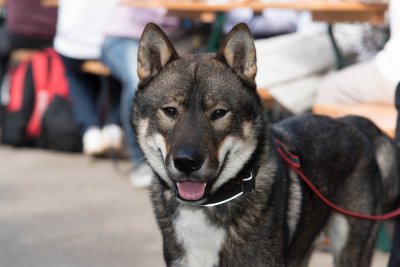
If you hadn’t heard of the breed Shikoku, you might think you have seen a Siberian Husky mix, but not quite. The more you stare at a Shikoku, the more you start to believe that he looks like a combination of many other breeds. You aren’t that far off if you think that this handsome hound looks like an Akita. Besides, this breed originated in Japan and hailed from the mountainous region of Shikoku Island, where he got his name from.
The Shikokus of old performed admirably as hunting and tracking dogs. These brave canines have the endurance and speed to hunt big game despite their medium stature. However, there were many incidents where some Shikokus were mistaken as juvenile wolves because their coats look similar in color. While these dogs are fierce, they don’t tend to be aggressive without reason. Long story short, these cuties use their heads! Shikokus tend to choose the best course of action, instead of blindly attacking someone without knowing what exactly they are getting themselves into.
Shikokus can figure out things far more quickly than most dogs, and once they get the hang of things, they will do what you are trying to get them to do so they can please you. Nevertheless, this good fluffy boy still needs a consistent owner with a firm hand to keep himself out of trouble.
- Size: Medium
- Avg. weight: 35 – 55 lbs. (male and female)
- Shoulder height: 19 – 22 inches (male), 17 – 19 inches (female)
- Color variants: red sesame, black sesame, sesame
- Coat type: thick and straight topcoat with a soft, dense undercoat
- Exercise requirements: 1 – 2 hours per day
- Personality: intelligent and versatile, enthusiastic and eager to please, loyal and courageous, affectionate and submissive
Kishu Ken
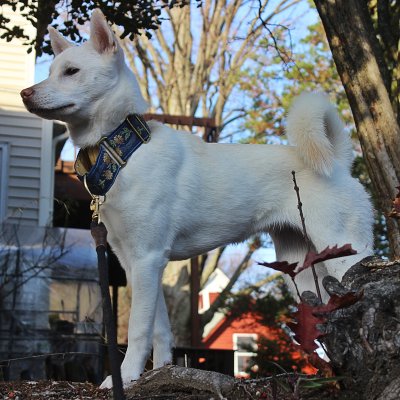
The Kishu Ken is indigenous to the mountainous regions of Kishu; thus, he takes after the name of the place he came from. Initially, the breed came in different coat colors, but only solid colors have been accepted since 1934. Exporting a Kishu Ken from Japan is an arduous process, partly because he has been on the Japanese Protected Species list since 1934. Nevertheless, some dog fanciers were able to bring Kishus on American soil and petitioned the AKC to include the breed in their Foundation Stock Service.
The Kishu Ken’s devotion towards his family makes him an excellent guard dog. Not to mention how intelligent and cunning he is! Instead of alerting a trespasser through barking, he cunningly stalks his adversary and pins him down. He can even climb steep slopes and climb trees like a cat! Kishus can also be chummy towards children, especially when he is raised together with them. This courageous pooch will do whatever it takes to protect his pack!
Although the Kishu Ken no longer hunts wild boars, his high prey drive persisted. His dominant demeanor is also an issue. So, it is best not to have any other pet than him. He might stir trouble otherwise and chew on your pocket pets like a Kong ball.
- Size: Medium
- Avg. weight: 30 – 60 lbs. (male and female)
- Shoulder height: 19 – 22 inches (male), 17 – 19 inches (female)
- Color variants: white, red
- Coat type: coarse, short and straight double coat with a thick, soft undercoat
- Exercise requirements: 30 – 60 minutes per day
- Personality: loving and faithful, cunning and agile, jealous and dominant, aloof with strangers, has strong protective instincts
Kai Ken
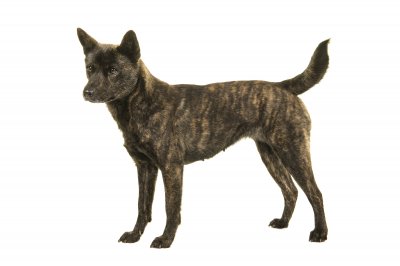
The Kai Ken is among the oldest dog breeds that originated from Japan. For many years, this hunting dog remained isolated to the province of Kai, which is an island of Honshu. The area was so mountainous; thus, the natives and their dogs were secluded away from the rest of the country. Crossbreeding was unlikely. That is why historians believe that the Kai Ken is the “purest” among the six Japanese dog breeds.
Locals often call the Kai Ken the “Tiger dog.” Not only because he sports a tawny coat with black stripes, but also because he is as fierce and cunning as a tiger. The Kai Ken stands out when it comes to hunting ungulates and wild boars. Adding to that, he is well-known for swimming after his prey, as well as climbing up a tree to retrieve his prize.
While the Kai Ken managed to make it into modern times, he remains a rare sight even to his native land. This charming pooch doesn’t have a world-wide-web presence, like the Akita and Shiba Inu. Nevertheless, the Kai Ken is classified as a national monument within his homeland.
- Size: Medium
- Avg. weight: 25 – 55 lbs. (male and female)
- Shoulder height: 20 – 22 inches (male), 18 – 20 inches (female)
- Color variants: black brindle, red brindle, brindle
- Coat type: harsh, medium-length straight coat
- Exercise requirements: 1 – 2 hours per day
- Personality: sharp and active, adventurous and restless, friendly and playful, reserved with strangers, has strong protective instincts
Hokkaido Inu
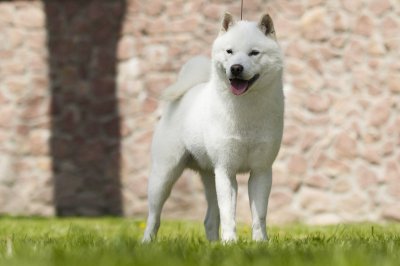
Back in the day, the Hokkaido Inu was known as the Ainu Dog. The breed first appeared when the Ainu Tribe arrived at the mountainous region of Hokkaido, roughly 3,000 years ago. The dogs facilitated the tribe in hunting salmon, wild boar, and deer for food, as well as regulating the population of bears. The Ainu tribe is thought to have treated these canines in the same way as human beings, as well. In 1937, the name was officially changed to Hokkaido Inu, but the dogs also go by the monikers Seta and Dō-ken.
The Hokkaido Inu is quite an adventurous dog, so let him be! This pooch likes to hunt rodents, birds, and snakes. Besides, he won’t lose his way since he possesses an innate sense of direction. Because of his high prey drive, it is wise not to adopt small pets, as he might include them to his collection of toys.
And while this breed is a genius, he will refuse to listen to you if you don’t possess the qualities of a pack leader. Luckily, he is food motivated. Take note that Hokkaidos have a different style of playing. They like to crouch, sneak, and howl when they are happy.
- Size: Medium
- Avg. weight: 45 – 65 lbs.
- Shoulder height: 19 - 20 inches (male), 18 – 19 inches (female)
- Color variants: black, brindle, white, black and tan, wolf-gray, sesame
- Coat type: long, stiff topcoat with a shorter and softer second coat
- Exercise requirements: 1 – 2 hours per day
- Personality: intelligent and competitive, playful and energetic, bold and adventurous
4 Equally Amazing Pooches in Japan
Japanese Chin
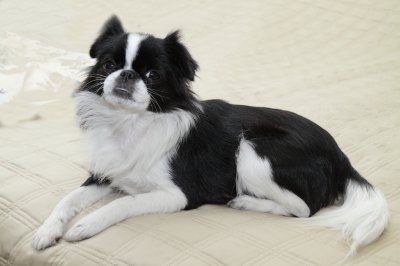
The Japanese Chin, sometimes referred to as the Japanese Spaniel, is the pampered pooch of Japanese aristocrats. The term “chin” translates to “perform a lot of tricks,” which the pooch is fond of doing. While this toy breed has a long history of Japanese nobility, nobody knows precisely where and how they arrived in Japan. Some believe they were gifts to the Empress in the 6th century, while others guessed they come from China. After all, Chins are quite famous in China, as seen in décor, temples, and pottery.
- Size: Small
- Avg. weight: 3 - 15 lbs. (male and female)
- Shoulder height: 8 – 11 inches (male and female)
- Color variants: red and white, lemon and white, sable and white, black and white, tri-color
- Coat type: moderately long and silky
- Exercise requirements: 30 – 60 minutes per day
- Personality: bright and independent, sensitive, standoffish or timid
Japanese Spitz
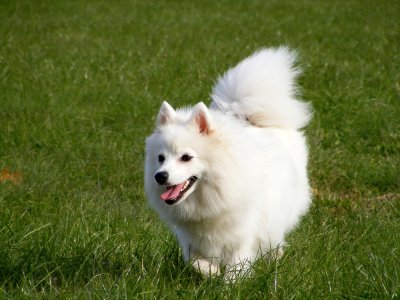
The history of the Japanese Spitz is a contrast to its bright, cottony fur. Some sources say this cutie descended from the Samoyed, as the tiny pooch looks precisely like a mini version of the sled-pulling dog of Siberia. Others guessed this pooch was the fruit of crossbreeding various Spitz breeds around the globe. Despite its murky origins, it is difficult not to fall in love with this fabulous little canine. This pooch is affectionate, energetic, and fun-loving to boot.
- Size: Small
- Avg. weight: 10 - 20 lbs. (male and female)
- Shoulder height: 10 to 16 inches (male and female)
- Color variants: white
- Coat type: thick and coarse outer coat with a fine undercoat
- Exercise requirements: 30 – 60 minutes per day
- Personality: enthusiastic and eager to please, loyal and affectionate, alert and smart, playful and energetic
Tosa Inu
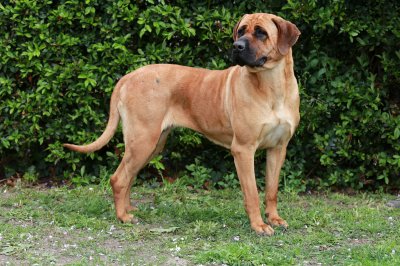
Imagine a dog as a robust and imposing as a Sumo wrestler, and you will probably have the Tosa Inu! Also known as the Japanese Mastiff, this canine giant often scares people off with their massive size and dark history. True, Tosa Inus were fierce fighters in the ring, but gone are the days of cruel blood sports. These canines possess a calm but vigilant demeanor and are often marked by patience.
- Size: Large
- Avg. weight: 100 – 200 lbs. (male and female)
- Shoulder height: 24 – 32 inches (male), 22 – 28 inches (female)
- Color variants: black, fawn, brindle, red
- Coat type: short and dense
- Exercise requirements: 1 hour per day
- Personality: intelligent and patient, fearless and protective, wary of unfamiliar people and aggressive to other dogs
Japanese Terrier
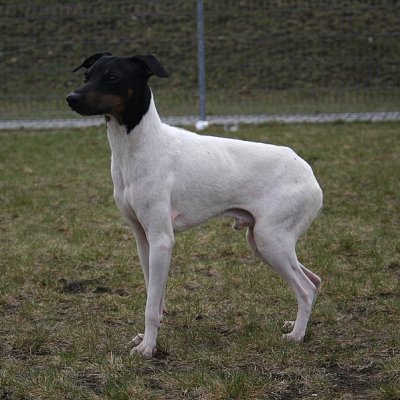
The Japanese Terrier is a tiny yet muscular dog with a lively gait. He adapts well to apartment life, but he also enjoys chasing things outdoors. However, he doesn’t fare well with extreme climates. So, you must provide him a warm blanket when it is cold. This lapdog is devoted and affectionate, but he can also get possessive of his favorite humans.
- Size: Toy
- Avg. weight: 6 – 9 lbs. (male and female)
- Shoulder height: 11 – 13 inches (male and female)
- Color variants: white with black mask
- Coat type: short and silky
- Exercise requirements: 30 – 60 minutes per day
- Personality: vigilant and lively, jealous and territorial, sensitive
Conclusion
The Japanese have great respect and reverence towards animals. While there are a handful of other popular pooches in Japan, only the Shiba Inu, Akita Inu, Shikoku, Kishu, Kai Ken, and Hokkaido Inu are true natives. The Nihon Ken Hozonkai, which translates to The Association for the Preservation of the Japanese Dog, aims to preserve and maintain their six natural treasures. These breeds are rare imports, making them expensive. If you have the money to spend, you should be vigilant and proactive, as most of these breeds require proper training, early socialization, and a confident Alpha. How about you get a Japanese Spitz, instead?
References and further reading:
- Proc Jpn Acad Ser B Phys Biol Sci. 2006. Yuichi Tanabe. Phylogenetic studies of dogs with emphasis on Japanese and Asian breeds
- Michiko Chiba and Lucy North. (2003).Japanese Dogs: Akita, Shiba, and Other Breeds
- Wikipedia.org. Dog breeds originating in Japan